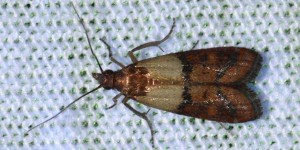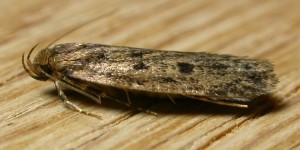Which Moths Thrive in the Kitchen?
If you spot a single adult moth in your kitchen, it could simply be one that has wandered inside, especially in summer when moths thrive outdoors and windows are often open. However, it may also be a sign of a moth infestation.
Finding multiple adult moths in your kitchen is an almost certain indicator of a moth infestation.
In any case, you should inspect your dry food for signs of moth presence. What you're really looking for are the larvae and their droppings rather than the adult moths themselves.
If you discover moths in the kitchen, it is likely either the Indian meal moth or the brown house moth.
4 Steps to Combat Pantry Moths
If you follow these four steps, you can generally eliminate pantry moths quite easily:
-
Inspection: Open all bags and containers of dry food and inspect them carefully for the presence of larvae, their webs, or droppings. The droppings often cause the food to clump together or appear slightly spoiled. The larvae's eggs are very small and hard to see, and what people often think are eggs could actually be droppings.
-
Disposal: You should dispose of all food that has been attacked by moth larvae. If the damage is limited, you could remove the affected parts and freeze or heat the rest at -18°C for two days or at +55°C for one hour.
-
Cleaning: Empty all kitchen cabinets of food and thoroughly vacuum them, especially in cracks, corners, holes, and other hard-to-reach places. Wipe down surfaces with a cloth dampened with vinegar and peppermint oil. Never use water, as this will give moths an even better living environment!
-
Prevention: Store all dry food in airtight containers and place bay leaves in your kitchen cabinets. This will reduce the chances of moths laying eggs, thus significantly decreasing the likelihood of future infestations. Additionally, set up flour moth traps to prevent and combat pantry moths.
In cases of severe infestations, you may need to inspect all movable items in the kitchen and even take down kitchen cabinets to check behind them.
If moth larvae or eggs are found behind these items, they should be removed by vacuuming and cleaning as described above.
Where Do Moths Come From?
Moths can enter your kitchen in two ways:
-
Via food: When purchasing dry food from a supermarket, there is always a small risk that moth eggs or larvae are present. Often, the issue needs to be traced back to the distribution or production of the food, where moths lay their eggs. As a consumer, it’s important to inform your retailer if you find moths in your purchased food.
-
From nature: Moths can enter your home from the outdoors. This is especially true of species like Indian meal moths, brown house moths, and others, which may live in bird nests and insect hives around the home. In summer, open kitchen windows may allow moths to enter, which can then lead to an infestation.
In other words, moths found in kitchen cabinets always originate from outside. However, once they have established themselves, they must be dealt with in the kitchen itself. In these cases, they often hide behind kitchen elements like cabinets, stoves, refrigerators, and exhaust hoods.
Which Moths Live in the Kitchen?
When moths are discovered in a US kitchen, it is usually Indian meal moths, although other species can also appear. Below is a list of moth species that thrive in kitchens and how common they are:
- Indian meal moth (very common)
- Brown house moth (common)
- Clothes moth (occasionally found)
- Mediterranean flour moth (rare)
- White-shouldered house moth (rare)
Other species may occasionally appear in kitchens, but these cases are very rare.
It’s important to note that pantry moths, which feed on kitchen food, are attracted to light and often fly around. In contrast, moths who attack clothes, which feed on textiles, are light-averse and prefer crawling rather than flying.
Moths in Food
All of the above moth species feed on dry foods such as:
- Grains
- Bran
- Rice
- Flour
- Bulgur
- Semolina
- Polenta
- Beans
- Cereals
- Spices
- Chocolate
- Instant coffee
However, they don't only target dry food. Some species can also feed on decaying food, as well as items like tea, tobacco, and similar products.


